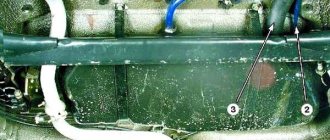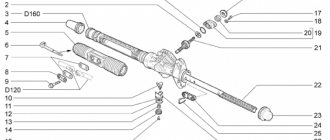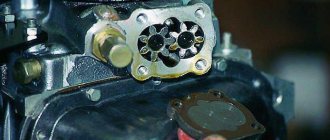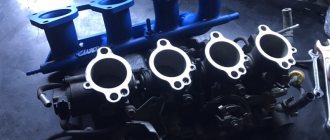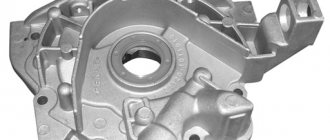Oil change intervals
Almost any driver knows the regulations for replacing technical fluids in his car, which are established by the manufacturer. But, in addition to the recommended timing, there are cases when the oil needs to be changed “unscheduled”. Such cases include, for example, carrying out a major engine overhaul or running-in. In the latter case, the oil change should occur after 3000 km. This is done in order to eliminate the consequences of break-in, that is, to remove chips from the engine.
Subsequent replacements are carried out after the car “passes” 10-15 thousand kilometers. Considering the quality of motor oils, it is recommended to do this more often, at least once every 8 thousand km.
Remember! The more often the engine oil is changed, the cleaner the engine is from the inside and the longer it retains its service life.
An oil change on a VAZ 2110 with a manual transmission is performed once every 40-60 thousand kilometers, and in an automatic transmission - every 60-80 thousand kilometers.
Required volume
Before buying motor oil, you need to decide on the volume. The best option is to purchase a 4-liter canister, which will last for a long time. This is convenient, because you can add the remaining liquid as the liquid is consumed, without worrying about buying a new one every time.
Well, now specifically about the one-time filling volume. The engine model plays an important role here. The VAZ 2110 used two engine variations. This is an 8-valve and 16-valve engine. In the first case, the volume of the oil sump is 3.2 liters, and in the second - 3.5 liters.
Rules for choosing oil
There are three basic rules for choosing engine oil for the “ten”:
- When purchasing, you must be able to distinguish a fake from the original. Counterfeit oils are a real problem in the modern car market. As a rule, those liquids that are counterfeited are those that have a high cost and are produced by famous brands. The use of such motor oils can have a detrimental effect on the engine.
- Every car owner should know about the approvals. Each car has its own motor oil tolerances, which determine the permissibility of using a particular liquid.
- Do not forget about the viscosity of motor oil, which depends on the region of operation, climate and weather conditions.
What to pay attention to
Now let's look at each of the above points in more detail. And first, let's return to fakes and understand the rules for identifying them. The easiest way to recognize it is to look closely at the canister. Even the slightest difference from the original will immediately reveal the efforts of the scammers. Non-original oil is also distinguished by another feature: the absence of a foil protective seal on the filler neck. It should be under the lid. If it is not there, the canister has already been opened, and not real oil was poured into it.
The optimal viscosity of engine oil for the VAZ 2110 is 5W40. Especially if the car is used with low mileage all year round. If the car is used quite often, for example in a taxi, then the oil should be selected according to weather conditions. In Russia, it is recommended to pour 0W30 in winter, and 10W40 or 15W40 in summer.
On a note! Sometimes, as an alternative to oil, regular mineral water is poured after break-in to save money.
A brief overview of the best motor oils
If a car owner finds it difficult to choose motor oil, it is recommended to pay attention to the following brands:
- Lukoil Lux. This is the cheapest motor oil for the VAZ 2110. It is recommended for use in cars with high mileage. Lukoil Lux is an ideal option for topping up, since the price of a liter canister is only 250-300 rubles. The oil has good cleaning properties, and, most importantly, no one will counterfeit a cheap liquid. After all, you must agree, this is unprofitable.
- Shell Helix HX8. This is a fairly high-quality oil for VAZ engines. Shell Helix has excellent lubricating properties and is ideal for all types of engines. It is more advisable to use this type of lubricant in an engine after a major overhaul or with a mileage of up to 200 thousand kilometers. In other cases, using this oil is a very dubious pleasure, since the price of a 4 liter canister is 2000 rubles.
- Elf. Not long ago Elf left the Renault assembly line, but was remembered as a good motor oil. Car owners began to pour it not only into popular foreign cars, but also into VAZ and
- Lada 110. To have a good effect, it is recommended to change Elf more often than required by the regulations. Ideally, it is recommended to reduce the frequency to 7-8 thousand kilometers.
How to choose an analog oil for the Lada Granta engine
An analog lubricant for the Lada engine must be selected according to parameters that are suitable:
- for the climate zone of the region where the car is operated;
- to engine power;
- to the power unit model.
Semi-synthetics are mainly used. It protects the Grant engine from the harmful effects of the rubbing part of the engine. The choice of a suitable fluid is approached thoroughly, referring to the book on the operation of the Grant engine, consulting with experienced mechanics.
Let's see how to determine which type of oil to pour into the Grant engine.
Similar article Installation of ignition and distributor drive on a 402 UAZ ZMZ engine
The basis
Engine oil for Lada Granta is selected based on its base. The eight-valve engine is filled with synthetic or semi-synthetic lubricant. Mineral based oil is not allowed. It does not have elements in its structure that would have a positive effect on the rubbing parts of the engine.
There are several types of liquids based on them:
- Basic.
- Basic with a high degree of purification.
- Obtained by hydrocracking.
- Derived from polyalphaolefins.
- Esters, glycols, etc.
Synthetic fluid has great advantages:
- viscosity does not change with increasing or decreasing temperature;
- have a small amount of additives;
- increasing anti-friction properties;
- reduction in fuel consumption.
Also, lubricants for Grant engines have approvals.
Tolerances
According to tolerances, the recommended oils for Lada Granta include B5D3. Lubricants are also divided into seasonal and all-season. It is best to use multi-purpose lubricants. They have an optimal set of properties that actively protect the Lada Granta engine.
Attention! A description of the approval can be found in the engine manual.
Lubricants must comply with current international standards. It is not recommended to use lubricants that are prescribed to work down to minus 25 degrees Celsius in colder conditions.
Viscosity
When buying oil for a Grant engine, they look at what viscosity it is. For example, in terms of viscosity, some oils may be all-season, while others are intended only for summer or winter.
If you take liquids for Granta according to the season, then those indicated in the table will do.
| Viscosity grade according to SAE J 300 | Temperature |
| 0W30 | — 25 – + 35 |
| 0W40 | — 35 — + 30 |
| 5W30 | — 30 — + 20 |
| 5W40 | — 30 — + 35 |
| 10W40 | — 25 — + 35 |
| 15W40 | — 20 — + 45 |
| 20W40 | — 15 — +45 |
In general, viscosity matters most in the world of oils. If the fluid is too viscous, then on cold days it will not allow the engine to start the first time. If it is too liquid, then in the summer the engine will constantly overheat.
Similar article Tightening torque of the cylinder head of a ZMZ 406 Gazelle engine with a torque wrench
Therefore, we select lubricant for Grant based on climate and engine model. If the original is not available, then it is replaced with lubricant from liquids of similar composition.
Possible analogues
Many car owners do not know what kind of oil to pour into the Grant, if, according to the recommendations in the engine operating book, those that are not sold in the region where the car owner lives are indicated.
Good analogues for lubricants are oils for Lada Granta from the following companies:
- Castrol Magnatec;
- Shell Helleks 5W40;
- ZIC, if there is no Lukoil Valvoline lubricant in the city.
Lukoil's semi-synthetic products are successful. This lubricant is quite popular. Finding it will not be difficult even in an urban village.
Experienced mechanics advise filling in the fluid that comes with the car from the factory. In this case, the car owner will have fewer problems with the power unit of the Lada Grant. Since factory lubricant is selected through many tests and tests. When it shows the best protective properties, then this is the oil that is used.
When adding lubricant, it is also not recommended to use lubricant from another company. Otherwise, both types of oils may react and render the engine unusable within 1 thousand kilometers.
A complete replacement of the lubricating fluid is carried out by draining the old one from the engine. Then the power unit system is cleaned, new consumables are installed, and only then fresh oil is added.
Oil change methods
Changing the lubricant can be done in two ways:
The first is relevant when completely replacing the fluid and switching, for example, to another manufacturer.
With engine flush
Depending on the type of flushing, replacing engine oil can be divided into two types:
- 5 minutes. This is the most popular type of flushing. How is everything going? A special cleaning fluid is added to old motor oil. Then the motor is started for 5 minutes and allowed to run without load. After this, the old oil is drained along with the flush. This method is good because the old lubricant becomes more liquid and is easily removed from the engine along with the dirt.
- use of flushing oil. The use of this flushing option when performing a procedure such as changing the oil on a VAZ 2110 is performed as follows: the old oil is drained, then the oil filter is changed, and flushing fluid is poured into the engine. After this, the car must be driven a certain distance without heavy load. Then this oil must be drained and replaced along with the filter. This is a more expensive and high-quality type of washing.
Attention! Flushing the engine is done at your own risk. The fact is that caustic substances can raise coked dirt in layers and clog oil channels. Because of this, the oil pressure in the engine may drop. This is especially dangerous for 16 valve engines. In order to properly flush the engine and fill in a new type of engine oil, it is recommended to use a longer flush.
No engine flushing
If the type, brand and model of engine oil does not change, then the replacement is performed without flushing. To do this, the old oil is drained, the filter is unscrewed, a new one is installed and fresh lubricant is poured in. You don't need to do anything else.
Step-by-step instruction
The entire procedure for changing the oil in a VAZ-2110 engine can be divided into several stages:
- removal of mining;
- washing;
- filter change;
- filling in new oil.
Since the filter is changed during each of the presented stages, it makes no sense to consider it as a separate part of the work.
Try to follow instructions and adhere to safety rules. To do this, securely secure the car, turn on the handbrake and put chocks under the wheels.
When everything is ready, you can start working.
Draining waste
The work begins with the engine compartment, and then gradually moves under the car, where the drain plug is located. It is easier to get to the oil filter through the hood.
There is no fundamental difference between changing engine oil on engines with 8 and 16 valves. The waste is drained according to the following instructions:
- Under the hood, unscrew the filler cap so that the oil flows out faster from below. This will prevent the formation of a vacuum, which reduces the rate of mining output.
- We find a drain plug under the car. First place an empty container with a volume of about 5 liters under it. After this, use the key to gradually unscrew it. The plug cannot be removed abruptly.
- When the oil begins to flow out, unscrew the cap completely and leave the container so that the liquid comes out completely. If the plug accidentally fell into the waste container, it’s not a big deal. When the oil has cooled, you can easily remove it from there.
- It will take at least 10 minutes for the liquid to drain completely. If the engine has not been preheated, the viscous lubricant will take longer to come out.
That's it, we got rid of the old grease. Let's move on to the next stage.
Flushing the system
It is not necessary to flush the engine every time you change the engine fluid. This procedure can be carried out approximately once every 80 - 100 thousand kilometers. If you see that the old oil is very dirty, then it makes sense to flush the system ahead of schedule.
To wash you need:
- Get rid of the old fluid and replace the drain plug.
- Pour a special flushing mixture through the filler neck. It should be located at o level. Therefore, use a probe.
- Start the engine of your VAZ-2110. Let it idle. In order for the flushing fluid to effectively remove all contaminants, the engine must be rotated for 10 to 15 minutes. Follow the product manufacturer's recommendations.
- Now drain the flush through the drain hole, repeating the previous step. Wait until all the flushing oil has left the system.
- To get rid of the filled chemicals, take fresh motor oil selected for your VAZ-2110. Repeat the washing procedure, but fill it with plain oil to the minimum mark. Drain it.
- Remove the oil filter. For this, it is better to use special pullers, since this cannot always be done manually or with other tools.
The penultimate stage is not necessary, but motorists often note that the presence of flushing residues in the engine negatively affects the physical and chemical properties of the working fluid itself. Therefore, additional operation in case of a heavily contaminated system will not hurt.
Fill
Now fill in fresh lubricant. There is nothing complicated here, but do not forget to change the filter at the same time.
- Wipe the filter seat with dry, lint-free cloths to remove all dirt. Fill the filter housing approximately 50% full with fresh engine oil. After lubricating the sealing gasket, screw the new filter element into place.
- The pan drain plug can be replaced completely or just the gasket on it can be changed. Over time, the seal wears out, causing a leak.
- The plug is first tightened by hand and then tightened with a wrench. Do not apply too much force, otherwise you will damage the integrity of the seal, and then you will not be able to dismantle it at all.
- No tools are required to install the filter. Screw in by hand. If the filter housing slips in your hand due to engine oil, wipe it clean and use gloves.
- Gradually begin pouring fresh lubricant through the filler hole. You should not fill the entire specified volume at once, since some of the liquid, even with the most thorough creaming, remains inside the system. Therefore, the actual amount of oil in the engine differs from what is indicated in the manual.
- Check the oil level with a dipstick. Do not insert the dipstick immediately after adding new lubricant. Let it drain. It is necessary to ensure that the probe shows a mark between the minimum and maximum values, exactly in the middle between them.
- If the level is correct, close the filler hole, start the engine and let it run for a while. The oil pressure warning light on the instrument panel should go out. If it goes out, everything is done correctly, the plugs and filter ensure a tight seal.
- Turn off the engine. Let the car sit for about 5 minutes. This will allow the oil to distribute throughout the system and drain into the crankcase. Now carry out a control level measurement. If it meets the requirements, the work can be considered completed.
- When the oil turns out to be less than normal, it is simply added in a small amount. Things are somewhat more complicated if there is an excess amount of lubricant in the engine, since you will have to crawl under the car again and drain the excess.
The work is completed, for which we congratulate you. As you can see, there is nothing complicated in this procedure.
The main questions are raised by the choice of oil itself, while its draining and replacement are carried out without special tools (except for a filter puller), special skills and extensive experience in car maintenance.
Follow the instructions and remember to follow safety rules when working with the machine.
Step-by-step instructions for changing the oil in a VAZ 2110
In order to change the engine oil on a VAZ 2110 without problems, you need to adhere to the following procedure:
- Place the car on a pit, lift or overpass. Warm up the engine to operating temperature.
- Unscrew the bolts securing the motor protection and remove it.
- Place a 4-liter container under the tray. A cut-off old canister works well for this.
- Unscrew the drain plug and let the old oil drain. While it is draining with both hands, you need to tear off the oil filter and dismantle it. If it does not unscrew, it is recommended to pierce it with a screwdriver and, using it as a lever, unscrew the old filter element.
- Install a new oil filter by first pouring a small amount of oil into it and lubricating the rubber band. Visually check that the filter valve is working properly.
- Replace the drain plug and screw on the protection.
- Fill in new engine oil to the level. Screw on the filler cap and start the engine. Make sure the pressure sensor goes out.
- Check the oil level after 3-5 minutes. If it is normal, there is no need to add it; if it is not at the level, it is recommended to drain the excess oil or add the missing oil.
The procedure is no different from the same one when changing the oil in a VAZ 2110 gearbox.
General issues
Let's consider general philistine questions about Granta and butter.
How to check the oil level in Grant
We check the level classically;
- The car must be turned off for at least 5-10 minutes;
- We take out the oil dipstick, wipe it with a rag and put it back;
- We take it out and look at the light - the level should be between MIN and MAX.
The dipsticks on the Lada suffer from the fact that they are difficult to read. You may need to wipe and lower the dipstick again.
When to change the oil of a VAZ 2190
According to the regulations, replacement on the Grant is required every 15,000 kilometers. Practical experience suggests replacement every 10,000 km. mileage, or once/twice a year.
The Grants are stuffed with Rosneft from the factory. The brand has not proven itself to be reliable and of high quality.
The first replacement occurs after the new car has been broken in - after 2000 km. This is not a requirement from the factory, but common sense - change the flooded s to something normal.
Which oil to choose
Next is a table with factory recommendations for Grants.
Excerpt from the documentation for the VAZ 2190.
Changing the oil in the gearbox on a VAZ 2110
To change the oil in a VAZ 2110 gearbox, you must do the following:
- Unscrew the drain plug using a 17 key. It is located on the side of the manual transmission.
- Drain the old oil.
- Screw the plug into place and, using a transmission oil filler, add new fluid until it begins to overflow. For filling, use another hole; it is located on the side. To access it, you need to unscrew the filler plug by 17.
When changing the oil in a VAZ 2110 gearbox, you must use exclusively transmission oils. Motorized ones are not suitable for this.
That's all you need to change the oil in a VAZ 2110 engine and transmission yourself. The most important thing is to have a standard set of tools. The rest of the procedure is quite simple.
Source
How and with what can this be done?
We suggest you familiarize yourself with the main methods that will allow you to dismantle the filter device with your own hands.
User Andrey Florida in his video explained how to replace the oil filter and what options are available for dismantling it.
Can you twist it by hand?
There are special tools for dismantling the filter device. But you can also unscrew it yourself. If the sticking of the device is strong, a tool or improvised devices will be required for dismantling.
Which way should I unscrew?
The filter is dismantled by turning its housing counterclockwise.
Special key
You can use a special key to unscrew it. This is an effective method, but to implement it you will need to purchase a tool. You will find several key options on sale:
- chain;
- clamping tool;
- tape;
- screw puller.
How to use it correctly?
To unscrew it with a chain or other special wrench, hook the filter device with a tool, securely fix it and remove it by turning it counterclockwise.
Rope (belt) and screwdriver
To remove the device without a tool, use a belt or rope with a screwdriver:
- A screwdriver is used to pierce the body of the filter device, as a result of which the tool is used as a lever. When using a screwdriver, you need to pierce the element right through, this will make twisting more effective.
- When using a belt or rope, the dismantling method simulates the use of a special key. The strap should be wide and made of leather or leatherette. A loop is made, after which it is tightened on the device itself counterclockwise. For quick dismantling, give a sharp tug on the rope or strap. The removal process may be difficult due to the strap slipping. Then insert a piece of sandpaper into the loop itself and perform the described steps again.
Replacement frequency
According to the official manual for the VAZ-2110, it is recommended to change the oil every 8-10 thousand kilometers on this Russian-made car. The frequency directly depends on the operating conditions.
In practice, in rare cases, a car can easily travel 10 thousand kilometers before scheduled maintenance. In fact, the quality of roads, climate, gasoline and a number of other factors significantly reduce the intervals between engine fluid changes. That’s why most car owners change it every 6–8 thousand kilometers.
The condition of motor oil and its physical and chemical properties are negatively affected by:
- regular driving in city conditions and constant traffic jams (the engine idles a lot of time);
- cold climate (low air temperature increases oil viscosity, which increases the load on engine components);
- operation of the machine in conditions of polluted, dusty and sandy roads;
- prolonged idle time of the car in a garage or in an open parking lot (condensation forms in the crankcase, mixing with oil);
- savings on consumables;
- refueling at cheap gas stations;
- aggressive driving style, etc.
When the lubricant begins to noticeably darken, this indicates its wear and the need for mandatory replacement in the near future. Darkening indicates that a large amount of combustion products has accumulated in the lubricant. Continued operation of the machine with worn oil can lead to serious consequences, including the need for major engine repairs.
Severe operating conditions
But sometimes you have to deviate from the instructions in the instructions and change the fluid more often. This is necessary if the car is operated in difficult conditions. These include the following situations:
- The car is regularly operated in dense city traffic jams, which is why the engine idles for a long time;
- The climate of the region where you live includes low temperatures and very cold winters. This causes the oil viscosity to increase and the load on the engine elements to increase;
- Operation on dusty or sandy roads soon leads to the oil becoming contaminated and losing its properties;
- The car stood idle for a long time, due to which condensation formed in the engine, which negatively affected the composition and quality of the oil used.
Determining that it is time to start replacing the fluid inside the engine is quite simple by its appearance. The oil becomes dark due to the accumulation of fuel combustion products . If you ignore the recommendations and drive for a long time with poor lubricant in the crankcase, this will lead to serious consequences and expensive repairs.
Engine oil change interval for Lada Granta
The engine lubrication replacement interval for this model, as for most other modern cars, is 10,000-15,000 kilometers.
On the new Grant, the first oil change was often carried out at a mileage of approximately 2000-3000 kilometers. There is no such recommendation in the current operating instructions. But experts strongly recommend changing the oil immediately after break-in.
If the Granta is rarely used and does not manage to travel 10 thousand kilometers in a year, it is still recommended to carry out the procedure annually.
When the car is often used in the city, constantly stuck in traffic jams, this operation needs to be carried out every 6000-8000 kilometers.
The lubricant should be replaced ahead of schedule when:
- Lack of oil. You can add more if its color and consistency have not changed. If this happens often, have the power unit diagnosed to determine the cause. Normal oil consumption may be exceeded when running in a new or repaired engine;
- Change in color or structure of oil on Granta;
- The appearance of foreign impurities in the oil. If metal shavings are present when the engine has been run-in, you should contact a motor mechanic;
- After 2000-3000 kilometers after a major overhaul of the power unit.
Materials
For all 16-valve engines on 2112 hatchbacks, the volume of the lubrication system is no different. It is 3.6 liters. When replacing, pour 3.3, and if the filter is changed, then 3.4 liters (plus another 100 ml into the filter itself). The choice of material does not depend on the engine type.
Brand Viscosity API quality class
| LIQUI MOLY OPTIMAL | 10W40 | SL/CF |
| LUKOIL-SUPER | 5W40, 10W40, 15W40 | SG/CD |
| LADA SUPER | 5W40, 10W40, 15W40 | SG/CD |
| ESSO ULTRA | 10W40 | SL, SJ/CF |
| MOBIL SUPER S | 10W40 | SL, SJ/CF |
| SHELL HELIX PLUS | 10W40 | SL/CF |
| HAVOLINE EXTRA | 10W40 | SL/CF |
| ZIC A PLUS | 5W30, 10W30, 10W40 | SL |
| MANNOL RACING | 15W40 | SL/CF |
| NOVOIL-SINT | 5W30, 5W40 | SG/CD |
| NOVOIL-SUPER | 5W30, 5W40, 10W30, 10W40, 15W30, 15W40, 20W50 | SG/CD |
| UTEC NAVIGATOR | 5W40, 10W30, 10W40, 15W40, 20W40 | SG/CD |
| MANNOL ELITE | 5W40 | SL/CF |
| ESSO UNIFLO | 10W40, 15W40 | SL, SJ/CF |
| TNK SUPER | 5W40, 10W40, 15W40 | SL, SJ/CF |
| SHELL HELIX SUPER | 5W40, 10W40 | SL/CF |
| MOBIL 1 | 0W40 | SL, SJ/CF |
| MOBIL SUPER M | 10W40, 15W40 | SL, SJ/CF |
| VALVOLINE DURABLEND | 10W40 | SL/CF |
| MANNOL CLASSIC | 10W40 | SL/CF |
| VISCO 2000/3000/5000 | 10W40 or 15W40 or 5W40 | SL/CF |
| LUKOIL-LUX | 5W40, 10W40, 15W40 | SJ/CD |
| MANNOL EXTREME | 5W40 | SL/CF |
On a working engine, the oil level between changes remains above the MIN mark. That is, they do not top up. In general, on the VAZ-2112, oil changes are performed once every 15 thousand km. The filter is changed at the same time.
The use of API SF oils on engines 21124 or 21120 is unacceptable. There are no such materials on our list.
Functions of an oil filter in a car
In a car, all parts tend to come into contact with each other, and to prevent wear due to friction, it is necessary to periodically change the lubricant. But to prevent dust, dirt, scale, chips and other particles from getting into it, an oil filter is needed. Its main function is to clean motor fluid from impurities and microparticles.
The automaker's instructions give clear advice: in a VAZ 2110, the oil filter should be replaced every 15-20 thousand kilometers, and in difficult and intensive vehicle operating conditions, the replacement frequency is reduced to 6-7 thousand kilometers.
Thus, it is necessary to check the condition of the oil once every 5 thousand km. If it has darkened and acquired a different consistency, you should urgently repair the oil filtration system and replace the engine fluid.
Several factors influence the frequency of repairs:
- year of manufacture and service life of the vehicle;
- performance of all car parts;
- driving style;
- quality of the liquid being poured;
- the quality of the fuel mixture on which the car is operated.
Tip: To find out the location of the filter device, you need to study the car's maintenance instructions or crawl under the bottom of the car.
The VAZ 2110 has an accordion-shaped filter with folded paper-type fibers. When choosing a new element, you must take into account the manufacturer’s recommendations and install the original part.
However, choosing a new oil is much easier than choosing a new filter. Today, most brands produce low-quality devices or pass off counterfeits as original filtration. And, although this also applies to oil, it is easier to fake a filter element.
To choose the right new element, you need to consider:
- strength of the body and cassette material;
- pricing policy;
- brand promotion.
The oil filter does not unscrew: what to do?
If you can’t unscrew the oil filter yourself, you can suggest that someone who has more strength try to do it. In most cases, you can unscrew even a strongly “stuck” oil filter without unnecessary tricks. But when you cannot unscrew the element even with outside help, you can use one of the methods described below:
Special wrench for oil filters. In automobile accessory stores you can find a special wrench designed to unscrew oil filters of various diameters. It is enough to hook such a key onto the element and then start rotating. Using it to unscrew the oil filter is not difficult, but not all drivers have such a key, and you must first purchase it;
Please note: Some drivers recommend not punching through the filter with a hammer, but rather driving a screwdriver into the area of the mounting location with a hammer. Doing this is quite dangerous, since the screwdriver may accidentally fall off and pierce the engine components.
Drain the old oil
Place an empty container to drain the waste - about 5 liters of old lubricant should flow out, this will take about 15-20 minutes.
First of all, you need to unscrew the oil filler cap - this will avoid the formation of a vacuum and drain the old mixture as much as possible.
Before changing the mixture, warm up the engine . High temperature oil has a lower viscosity , which allows it to flow out better and more efficiently .
Next, remove the drain cover and give time for all the waste to flow out. If the drain plug falls into the waste mixture, it’s not a big deal. Once everything has cooled down, it can be easily removed and cleaned. Once all the oil has drained away, this stage is over.
Flushing the system
Having drained all possible liquid, a small amount remains In order for the oil change to be as effective as possible, it is recommended to flush the system.
To do this, you need to close the plug on the drain hole. The flushing solution is injected into the filling hole to the “minimum” level. Afterwards, at idle speed, the engine should run for about a quarter of an hour . This liquid dissolves the remaining engine mixture and possible sediment, thus cleaning the system.
The engine is turned off - drain the flushing fluid in exactly the same way as old oil. Now is the time to replace the oil filter . The old filter is dismantled, engine oil will drip from this hole for some time, you need to wait until this process is completed. Then a new one , into which about 300 ml of motor fluid is first poured.
Preparatory activities
To prepare for changing engine oil, you will need to collect the necessary materials, tools and take into account some of the features of this procedure.
- In order for more oil to leave the system, you need to start work immediately after a trip or with a warm engine. Just run it at idle speed for a few minutes. When oil is warm, it becomes more fluid. This allows the lubricant to drain as much as possible and eliminates the need for flushing.
- Only fill in the oil that was previously used in the engine. Not only the characteristics of the oil must match, but also its manufacturer and specific type.
- If you are switching to another type of oil, it is better to do a flush first. This is a simple, but useful and necessary procedure for the VAZ-2110.
You will also need replacement tools. The required list includes:
- spanners;
- dry rags;
- new filter;
- fresh motor lubricant
- puller key for the oil filter (you can do without it);
- pit or lift;
- funnel;
- container for used oil.
It is recommended to additionally use thick clothing, closed shoes and gloves. Since the oil is hot, when unscrewing the drain plug there is a possibility of liquid getting on your skin. Professionals easily cope with this task, but beginners get burns quite often. Therefore, be extremely careful.
Replacing the oil filter
If the filter will not be replaced, proceed to the next chapter. The filter housing is very easy to find: you need to stand near the right wheel and look under the exhaust manifold.
Found the oil filter housing
The old filter can most often be unscrewed by hand. If that doesn't work, take a puller. Installation of a new filter is done as follows:
- Residues of “working off” are removed from the crankcase;
- The filter housing is filled halfway with oil (100-120 ml). Also lubricate the rubber gasket with oil;
Prepared the part for installation
- The new filter is installed in place.
The tightening force for the filter housing is 37.48–87.47 N*m.
Instead of a puller, a screwdriver is sometimes used. Then the filter jar is pierced closer to its bottom!
Replacement operation
It is recommended to change the oil only when the engine is warm. And yet, it would be better to drive the car into a pit. Otherwise, you will have to find the drain plug by touch. Only the replacement procedure is discussed here. A list of recommended materials is provided in Chapter 3.
Disconnecting the battery from the network
First of all, you will need to disconnect the negative terminal. Here you need a “10” wrench (see figure). Next, unscrew the filler plug, and then perform the following steps:
- Make sure that the filler neck has been opened;
- Use a 12mm spanner to unscrew the drain plug. It is not necessary to remove the crankcase protection (Fig. 1);
Unscrew the plug (Fig. 1)
Let the oil drain into a 4 liter container (Fig. 2)
Removing the filter (Fig. 3)
The rubber seal must be in oil (Fig. 4)
If the filter has been changed, add another 100 ml to the indicated figures. Steps 2, 3, 5 and 6 are illustrated in the photo.
The last step is to connect the battery to start the engine. It is necessary to ensure that the control lamp goes out. Then check the oil level using the dipstick and, if necessary, top up (100-200 ml).
This engine warning light should come on for a couple of seconds after starting.
The oil level dipstick will have MIN and MAX marks. What they mean is clear to everyone. By the way, the volume of the lubrication system is 3.5 liters, but 300-500 grams of “working off” always remains in the engine.
Choosing a puller
What kind of universal pullers have not been invented to make life easier for the car owner. But any puller always belongs to one of the types: chain, rod or plier puller. Each of the three types is illustrated in the photo.
Everyone knows that universal pullers are inconvenient to use. Yes, and they are expensive. Therefore, sanding paper, cloth gloves, etc. are used. But it often turns out that the filter is screwed on tightly.
The outer diameter of the Granta oil filter is 76 mm. A part manufactured by Renault can serve as a puller for it. This part is shown in the photo, and it is called a “cup puller”.
Oil filter puller Renault (7711381992)
The number of the specified part in the Renault catalog will be as follows: 7711381992. Typically, those who do not use pullers are recommended to do this:
- It is necessary to pierce the filter housing with an awl or a flat screwdriver;
- The screwdriver should go 40-50 mm into the filter cavity. It is then used as a lever.
Maybe these tips are worth considering. The main thing is that what is shown in the figure below does not happen.
Oil filter after replacement
Use common sense, and then everything will work out. Good luck.
You need to pierce the oil filter housing closer to its bottom. Otherwise, you may hit the engine fitting. By the way, a broken filter will leak waste. In general, the screwdriver method is used in extreme cases.
Fill
Now we have reached the last step - adding new oil to your car's engine. The procedure for the VAZ 2110 looks like this:
If you strictly follow the instructions and also correctly select the lubricant for your VAZ 2110, the replacement procedure will become an easy task for you, which you will cope with on your own in literally an hour.
So that you understand, the cost of such a procedure, not counting washing, at a service station will cost you at least 500 rubles. So the ability to change the lubricant in the engine with your own hands is also a great way to save your budget. Considering that replacement is carried out approximately once every 8 thousand kilometers, you can save a lot of money over the entire period of ownership of your VAZ 2110.
List of parts and equipment
To simply change the engine oil, the owner of a car with an automatic transmission will need a core wrench. The standard size “6 edges by 8 mm” is suitable. In principle, you don’t need anything else except a flat key “10”. They unscrew the battery terminal with it.
Plug key for all trim levels with automatic transmission
For those who have a mechanical transmission, it is easier to use a set of ring wrenches. We need standard sizes 8, 10 and 12 mm. That's all.
Let us indicate how the drain plugs are designated in the AvtoVAZ catalog:
- 21120-1011061-00 – plug for equipment with automatic transmission;
- 21080-1011062-00 – washer for the plug (automatic transmission only);
- 21080-1009156-00 – option for cars with manual transmission.
The filler plug is designated by the numbers 11190-1009146-00. And the control dipstick is a part from the VAZ catalog with number 21120-1009045-00.
To unscrew the oil filter housing, use a puller. There are universal pullers on sale, and a cup puller (Renault 7711381992) is also suitable. The choice is made based on standard parameters: diameter is 76 mm, number of edges is 12.
Cup puller
If we talk about the oil filter itself, part 21080-1012005-08 was installed from the factory. This is a filter produced in the city of Livny. You can look for an imported replacement, but keep in mind that the height of the case should not be less than 70 mm. Otherwise, the oil will not cool well.
Selection of analogues
The screw plug that closes the hole in the crankcase of cars with automatic transmission is not a unique VAZ part. You can use analogues instead:
- Renault 77 03 075 348;
- Fa1 153.520.001 (for a tetrahedron rod).
If you remove the spaces from the top number, you get the designation of the traffic jam for Largus.
It will be more difficult to find a replacement for the washer. Renault, which produces part number 11026 5505R, will help here. Without a space, we again get the AvtoVAZ part designation: 110265505R - sealing ring from Lada Largus.
The VAZ plug number 21080-1009156-00 has its own long history. It appeared on Eights and is suitable for front-wheel drive Lada engines that are not equipped with an automatic transmission. A unique feature of the part is the presence of a tapered thread. Of course, it cannot be made on a lathe.
Finishing touch
Know that on a VAZ-2112, changing the oil does not end with one fill:
- 3.2 liters of new material is gradually poured through the neck;
- Start the engine and wait 3-4 minutes. It’s good if the Oil Can lamp goes out;
- Stop the engine, remove the dipstick, check the level;
You need to know how much to add
Changing the engine oil out of the blue
It may be useful to know that pits and overpasses are not necessary to change the oil on our cars. The drain plug on the oil pan is located just behind the right wheel. Therefore, to change the oil, it is enough to jack up the car, remove the wheel, turn the steering wheel to the right, bend back (for convenience, not critical for the job) the plastic protection and everything is ready to change the oil. The procedure took about 30 minutes. I think that you are familiar with the oil change procedure, so there is no need to describe it point by point. Just a couple of points: 1. If there is a slope, we stand with the starboard side down. When we jack up the car, it is leveled horizontally. If there is no tilt, then after unscrewing the drain plug, lower the jack to level the car. 2. Do not forget about safety measures when working with a car on a jack.
Source


